Chaparral is a shrubland plant community found primarily in the state of California and in the northern portion of Lower California, Mexico. It is shaped by a Mediterranean climate (mild, wet winters and hot dry summers) and wildfire. A typical chaparral plant community consists of densely-growing evergreen scrub oaks and other drought-resistant shrubs.
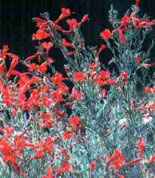 Common Name: California Fushsia
Common Name: California Fushsia
Latin Name: Zauschneria Californica
Native Habitat: Dry slopes below 2,000 feet from Baja California to Monterey County, California
Soil: Dry, decomposed granite, sand, clay loam, low organic content, well drained
Water: None to 1 ounce a month
Light: Sun or shade
Height X Width: Max: 18“ x 4 feet. Usual : 1 foot x 4 feet
Leaves or stems: Gre-green, finely textured, dormant in winter
The California Fushsia is used for erosion control and flowers are used by hummingbirds and butterflies.
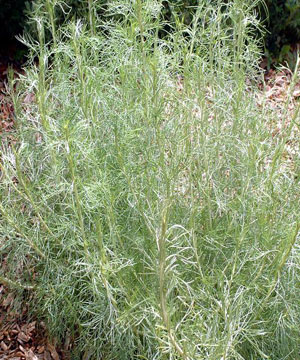 Common Name: California Sagebrush
Common Name: California Sagebrush
Latin Name: Artimisia Californica
Native Habitat: Coastal scrub, chaparral and dry foothills below 2,500 feet in dryer parts of central and southern California and Baja California
Soil: Dry, decomposed granite, sand, clay loam, low organic content, well drained
Water: None to twice a month
Light: Sun or shade
Height X Width: Max: 5 feet x 5 feet . Usual 3 feet x 3 feet
Leaves or Stems: Evergreen, silver, aromatic
The fruits of the California Sagebrush are eaten by birds and it is a larval plant for butterflies. The blue-green lacy foliage is useful for indigestion and stomach cramps. It can also be used as a scent in a sauna.
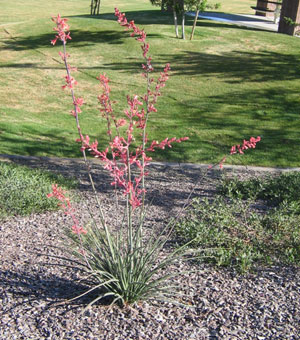 Common Name: Red Yucca
Common Name: Red Yucca
Latin Name: Hesperaloe parviflora
Native Habitat: Limestone hills, arroyos and mesquite thickets in Chihuahuan Desert, infrequent to rare in the wild
Soil: Moist to dry, decomposed granite, sand, clay loam, limestone, low to high organic content, well drained
Water: None to once a week
Light: Sun to partial shade
Height X Width: 2ft. X 3ft.
Leave or Stems: Evergreen
The flowers of the Red Yucca are used by hummingbirds. Red Yucca starts to bloom in mid-spring.
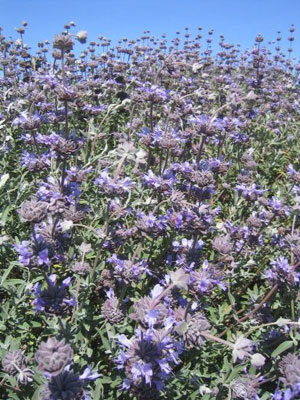 Common Name: Cleveland Sage
Common Name: Cleveland Sage
Latin Name: Salvia Clevelandii
Native Habitat: Chaparral, coastal sagescrub in mountains mostly below 3,000 feet from San Diego County to Baja California
Soil: Dry, decomposed granite, sand, low organic content, well drained
Water: None to once a month
Light: Sun or shade
Height X Width: Max: 5 feet x 6 feet. Usual 3 feet x 4 feet
Leaves or Stems: Silver, aromatic, fuzzy, evergreen or dormant in late summer
The leaves of the Cleveland Sage can be used to make herbal teas. Hummingbirds use the flowers. Sages are known for their fragrance. It is a popular plant because of its rich violet-blue flowers.
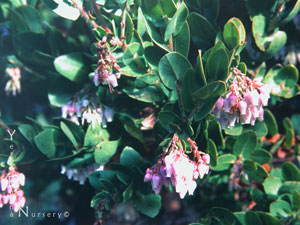 Common Name: Bigberry Manzanita
Common Name: Bigberry Manzanita
Latin Name: Arctostaphylos Glauca
Related species: Refugio Manzanita
Native Habitat: Dry slopes, chaparral below 4,700 feet from Contra Costa County to desert mountains to Baja, California
Soil: Dry, decomposed granite, sand, sandstone, low organic content, well drained
Water: None to once a month, drip irrigation
Light: Sun to partial shade
Height X Width: Max: 25 ft. x 20 ft.
Leaves or stems: Evergreen, pale blue, smooth or velvety
Blue Manzanita is the most common southern California manzanita.
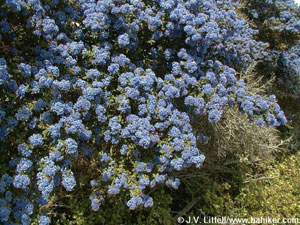 Common Name: Wild Lilac Hybrid
Common Name: Wild Lilac Hybrid
Latin Name: Ceanothus ‘Concha’
Native Habitat: Chaparral and coastal bluffs below 1,500 feet. Santa Barbara and San Luis Obispo Counties California
Soil: Dry, sand, low organic content, well drained
Water: None to once a month
Light: Sun or shade
Height X Width: Max: 10 feet x 8 feet
Leaves or stems: Evergreen, dark green, small and round
Flowers heavily beginning in late winter and produces clusters of luminous cobalt blue flowers. Flowers are used by butterflies and honey plant for bees.